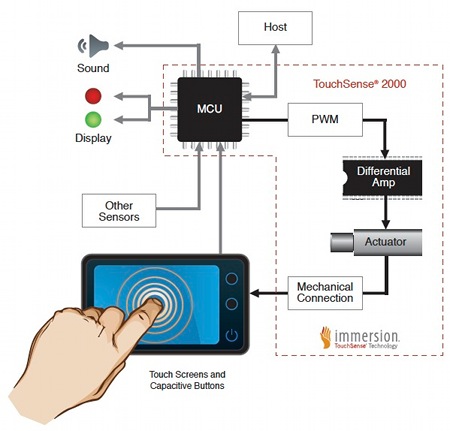Haptic technology targets Android tablets
Sep 1, 2010 — by LinuxDevices Staff — from the LinuxDevices Archive — 7 viewsImmersion Corp. announced technology designed to enable touch feedback effects for tablets and other devices running either Android or Windows 7. The “TouchSense 2500” solution has already been built into Toshiba's dual-screen tablet, the Libretto W100, the company adds.
San Jose-based Immersion says its haptic technology enables devices to provide tactile feedback, promoting a "more intuitive, engaging, and natural experience for the user." TouchSense is useful for both touchscreen devices, where it allows onscreen buttons to "press and release similar to mechanical buttons," and for products incorporating low-travel mechanical or membrane buttons, where it makes it easier for a user to distinguish one button from another, the company adds.
According to Immersion, its TouchSense solutions include:
- a "drop-in haptic processor" (an unnamed, third-party microcontroller)
- embedded tactile effect player software
- a library of tactile effects
- and the supporting circuitry required to drive actuators (sourced from third parties such as Jonlong, Sanyo, and Johnson)
When a user touches a membrane button or an area on screen, a position signal is sent to a host application, which then commands the lightweight TouchSense player — embedded on the microcontroller — to play a specified tactile effect, Immersion explains. The player responds by exerting control over a small actuator, causing it to play a tactile effect that gives the user the perception of pressing a button, the company adds.

Immersion's TouchSense 2500 technology
(Click to enlarge)
Immersion says its previous TouchSense 2000 and 2100 solutions targeted devices such as appliances, cameras, IP phones, PMPs (portable media players), PNDs (personal navigation devices), and printers. As such, they had limited haptic effects libraries and didn't include high-level operating system support, according to the company.
In contrast, the new TouchSense 2500 solution offers Android and Windows 7 drivers, and supports USB and I2C I/O in place of the previously offered I2C, SPI, and GPIO, Immersion says. Now targeting tablets, netbooks, notebooks, and ultra-portable PCs, it offers an "infinite" haptic effects library, the company adds.
 Haptic effects can not only be tailored to touchscreen graphical elements such as virtual keyboards or scrolling through lists, but can also provide feedback for gestures (such as tap, double-tap, swipe, spread, pinch, slide/drag and long press), according to Immersion. It's said a custom haptic effects tool allows device designers to create any haptic effect they want, including game effects, music effects, and texture simulation.
Haptic effects can not only be tailored to touchscreen graphical elements such as virtual keyboards or scrolling through lists, but can also provide feedback for gestures (such as tap, double-tap, swipe, spread, pinch, slide/drag and long press), according to Immersion. It's said a custom haptic effects tool allows device designers to create any haptic effect they want, including game effects, music effects, and texture simulation.
According to Immersion, its haptic technology — presumably in the new TouchSense 2500 iteration — has been incorporated into Toshiba's Libretto W100, pictured at right above. The $1,100 device runs Windows 7 on a 1.2GHz Intel Pentium U5400 processor, has 2GB of RAM and a 62GB SSD (solid state drive), and offers an accelerometer and six different virtual keyboards, according to Toshiba.
Immersion vice president of Marketing Dennis Sheehan stated, "Now standard in mobile phones, we're seeing increased adoption of touch-input interfaces across a range of other markets, most notably in mobile computing. TouchSense 2500 provides OEMs and designers an easy-to-implement haptics solution and makes these interfaces dynamic, ultimately pleasing users and differentiating products."
The Libretto W100
Source: Toshiba
(click to play)
Further information
More information about Immersion's haptic technology may be found on the company's website, here.
This article was originally published on LinuxDevices.com and has been donated to the open source community by QuinStreet Inc. Please visit LinuxToday.com for up-to-date news and articles about Linux and open source.